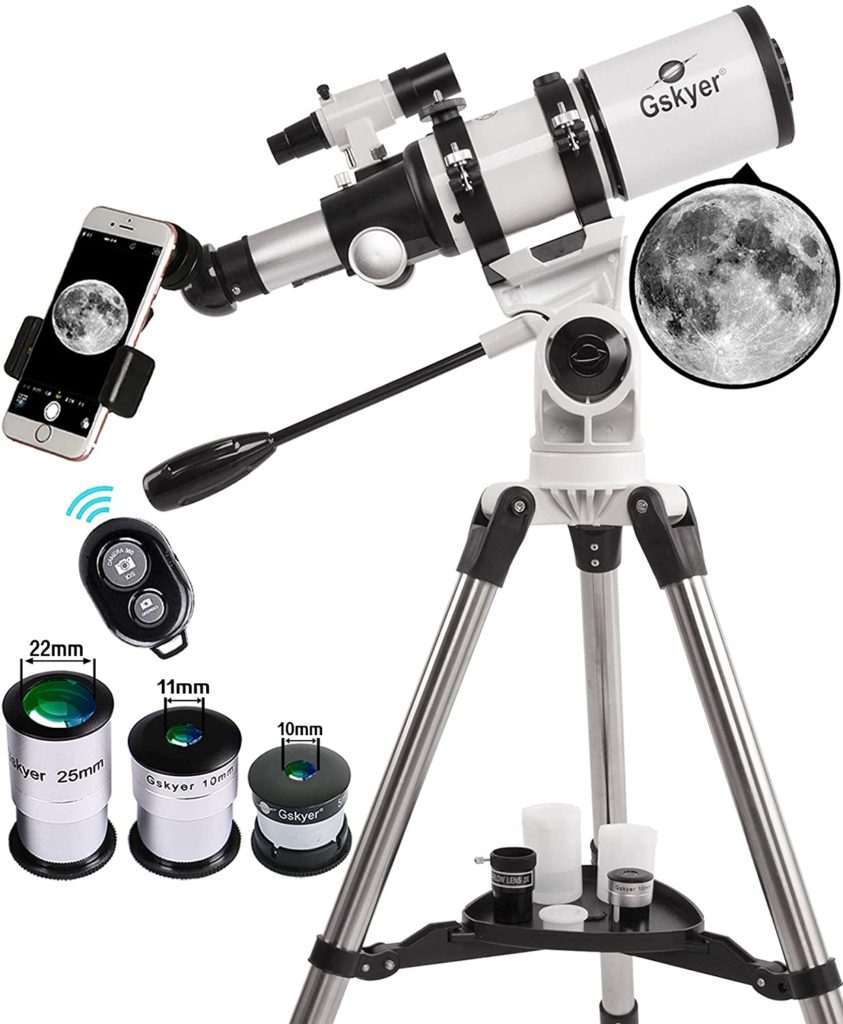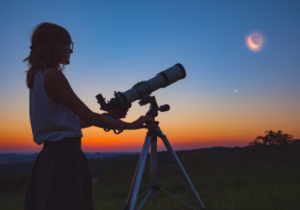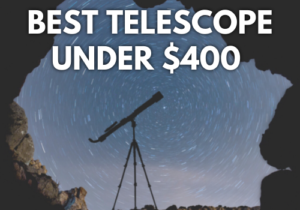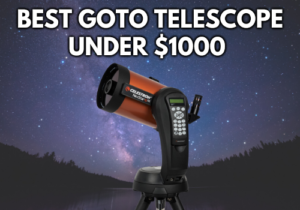Best Telescope Under $200 (2025); Reviews
Disclosure: This post contains affiliate links and I may earn a small commission (at no extra cost to you) if you click through and make a purchase. Thanks in advance – I really appreciate it!
Here in this “Best Telescope Under $200” article we’ve rounded up 11 of the best telescopes of various types, specifications, and budget perfectly suited for someone looking for a budget, affordable telescope model. Below, you’ll find in-depth reviews of each, as well as an elaborate buying guide to help you pick out the one that suits you the most.
COMPARISON TABLE
| Image | Title | Best For | Features | Price | Buy |
|---|---|---|---|---|---|
 Top
Top
Top
Top Top
Top
Top
Top | Celestron - PowerSeeker 127EQ | Best For Beginners | Type: Reflector, Aperture: 127 mm(5″), Focal length: 1000mm, Focal Ratio: f/8 | See on Amazon | |
 Top
Top
Top
Top Top
Top
Top
Top | Meade Instruments – Polaris 80mm | Best For Intermediates | Type: Refractor, Aperture: 80mm (3.2″), Focal length: 900mm, Focal Ratio: f/11.3 | See on Amazon | |
 Top
Top
Top
Top Top
Top
Top
Top | Orion 10015 StarBlast 4.5 | Best Reflector Pick | Type: Newtonian Reflector, Aperture: 115mm (4.53″), Focal length: 450mm, Focal Ratio: f/4 | See on Amazon | |
 Top
Top
Top
Top Top
Top
Top
Top | Celestron - AstroMaster 70AZ | Best Refractor | Type:Refractor, Aperture: 70mm (2.8″), Focal length: 900mm, Focal Ratio: f/13 | See on Amazon | |
 Top
Top
Top
Top Top
Top
Top
Top | Zhumell Z114 Portable Altazimuth Reflector | Best Tabletop Pick | Type: Reflector, Aperture: 114mm (4.49″), Focal length: 465mm, Focal Ratio: f/4 | See on Amazon | |
 Top
Top
Top
Top Top
Top
Top
Top | Emarth Telescope | Best Portable Pick | Type: Newtonian Reflector Aperture: 70mm (2.75″) Focal length: 360mm Focal Ratio: f/5.1 | See on Amazon | |
 Top
Top
Top
Top Top
Top
Top
Top | Orion StarBlast II 4.5 EQ Reflector | Best For Moon | Type: Reflector, Aperture: 114mm (4.5″), Focal length: 450mm, Focal Ratio: f/4 | See on Amazon | |
 Top
Top
Top
Top Top
Top
Top
Top | Celestron - PowerSeeker 80EQ Telescope | Best For Planets | Aperture: 80 mm (3.15″), Focal length: 900mm, Focal Ratio: f/11 | See on Amazon | |
 Top
Top
Top
Top Top
Top
Top
Top | Orion SpaceProbe II 76mm | Best To See Jupiter | Type: Reflector, Aperture: 76mm (3″), Focal length: 700mm, Focal Ratio: f/9.2 | See on Amazon | |
 Top
Top
Top
Top Top
Top
Top
Top | Celestron 21079 Cometron 114AZ | Best To See Saturn | Type: Reflector, Aperture: 114mm (4.49″), Focal length: 450mm, Focal Ratio: f/4 | See on Amazon |
Product prices and availability are accurate as of the date/time indicated and are subject to change. Any price and availability information displayed on [relevant Amazon Site(s), as applicable] at the time of purchase will apply to the purchase of this product.
Prices pulled from the Amazon Product Advertising API on: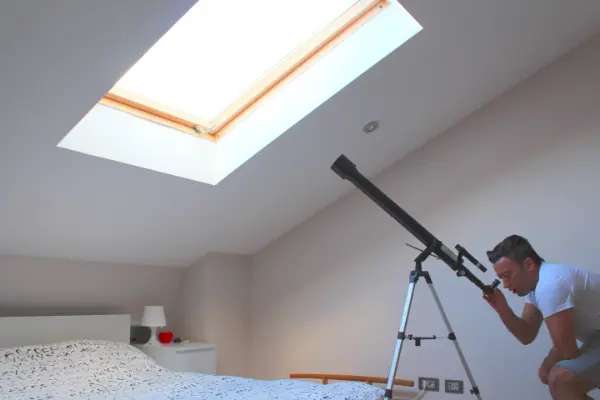
Best Telescope Under $200
Since there are so many options available in the market today, we did a survey among fellow astronomy enthusiasts, and consulted our in-house experts and came up with 11 popular choices for good telescopes under 200.
We then took a look at the entire popular telescope market, we combed through the details and customer reviews for dozens of scopes and chose the best affordable telescopes.
We’ve also included a telescope buying guide. If you want to learn more about telescopes before you buy, or just want to make sure you’re getting good value for your money, be sure to have a look at it.
Best For Beginners
Celestron – PowerSeeker 127EQ
- Type: Reflector
- Aperture: 127 mm(5″)
- Focal length: 1000mm
- Focal Ratio: f/8
- Mount: German Equatorial
- Eyepiece: 20mm, 4mm
- Magnification: 50x, 250x
- Weight: 22.0 lbs.(10.0 kg)
- Our Rating: 9/10
Prices pulled from the Amazon Product Advertising API on:
Product prices and availability are accurate as of the date/time indicated and are subject to change. Any price and availability information displayed on [relevant Amazon Site(s), as applicable] at the time of purchase will apply to the purchase of this product.
The Celestron PowerSeeker 127EQ telescope is a Newtonian reflector, which means it uses mirrors to gather the light of the skies, and reflects it for viewing. With mirrors being much less expensive to produce than glass lenses, reflector telescopes offer more value in terms of inches of aperture.
The PowerSeeker 127EQ comes with two eyepieces (4mm and 20mm) and a 3x Barlow lens.
The 5-inch mirror on the 127mm PowerSeeker model limits useful magnification to about 250x, which is achieved using the 4mm eyepiece.
The larger 20mm eyepiece provides a more useful 50x magnification. This grows to 150x when coupled with the 3x Barlow.
If you’re considering an additional eyepiece, something like a 15mm Plossi would be a good option. This provides you with 66x magnification, or 198 when coupled with the Barlow.
The telescope is ideal for near and deep-sky observation, Celestron’s PowerSeeker 127EQ 127mm f/8 Reflector Telescope features a respectable focal length and a large, parabolic mirror that produce detailed images of the Moon, clear views of the planets, and the ability to resolve bright distant objects such as nebulae and galaxies.
The beauty of a Newtonian telescope is the longer focal lengths which can be offered in much shorter tube sizes—1000mm focal length in a tube which is only 20 inches (508mm) long .
The PowerSeeker 127EQ is highly portable and one of the best telescope under 200. You could easily fit this telescope and tripod in the trunk of a car and still have room for your other equipment, or maybe a late night picnic.
Additionally, you receive a copy of Starry Night astronomy software with a database of over 10,000 celestial objects.
Considering the telescope’s low price, compromises had to be made, and one such compromise is the use of a spherical mirror rather than a parabolic mirror.
Optical aberrations tend to be more common with spherical mirrors. This telescope does, however, feature an erect image diagonal for the right way up images, which prevents some aberration.
This telescope comes with an Equatorial mount, designed for astronomy telescopes. Included are two manual slow-motion controls, these allow for smoother tracking of objects as they pass across the night sky.
The tripod is made of aluminum, although lightweight, it is robust, solid and also comes with a very handy accessory tray which lets you keep extra eyepieces and T-rings for a camera, close to hand.
Pros:
- Solid build quality
- Stable mount
- Comes with a 3x Barlow lens
Cons:
- Spherical mirror leads to some amount of aberrations
- Occasional collimation of the mirrors required
Best Intermediate
Meade Instruments – Polaris 80mm
- Type: Refractor
- Aperture: 80mm (3.2″)
- Focal length: 900mm
- Focal Ratio: f/11.3
- Mount: Equatorial
- Barlow lens: 2x
- Eyepiece: 26mm, 9mm, 6.3mm
- Magnification: 34.6x, 100x, & 143x
- Weight: 18 lbs.(8.2 kg)
- Our Rating: 8/10
Prices pulled from the Amazon Product Advertising API on:
Product prices and availability are accurate as of the date/time indicated and are subject to change. Any price and availability information displayed on [relevant Amazon Site(s), as applicable] at the time of purchase will apply to the purchase of this product.
The Polaris 80mm f/11.3 Equatorial Refractor Telescope from Meade is intended to take astronomic observation to the next level by providing a complete set up for viewing the Moon and planets, and brighter deep-sky objects like star clusters and galaxies.
Three eyepieces provide 34.6x, 100x, and 143x magnifications with a 2x Barlow lens that doubles the magnification of each eyepiece for a wider-range of observing possibilities.
It features a stable equatorial mount with slow motion controls that makes it easy to track celestial objects as they move across the night sky.
As a more advanced mount, it allows users to find just about any visible object by just knowing its coordinates. After the scope has been properly Polar Aligned, and the subject found, it can be easily tracked by making slight adjustments to the RA axis.
The included AutoStar Suite Astronomer Software is a particularly useful tool for planning observation sessions. It is loaded with more than 10,000 celestial objects including planets, stars, galaxies and nebulae, and star charts can be printed for use in the field.
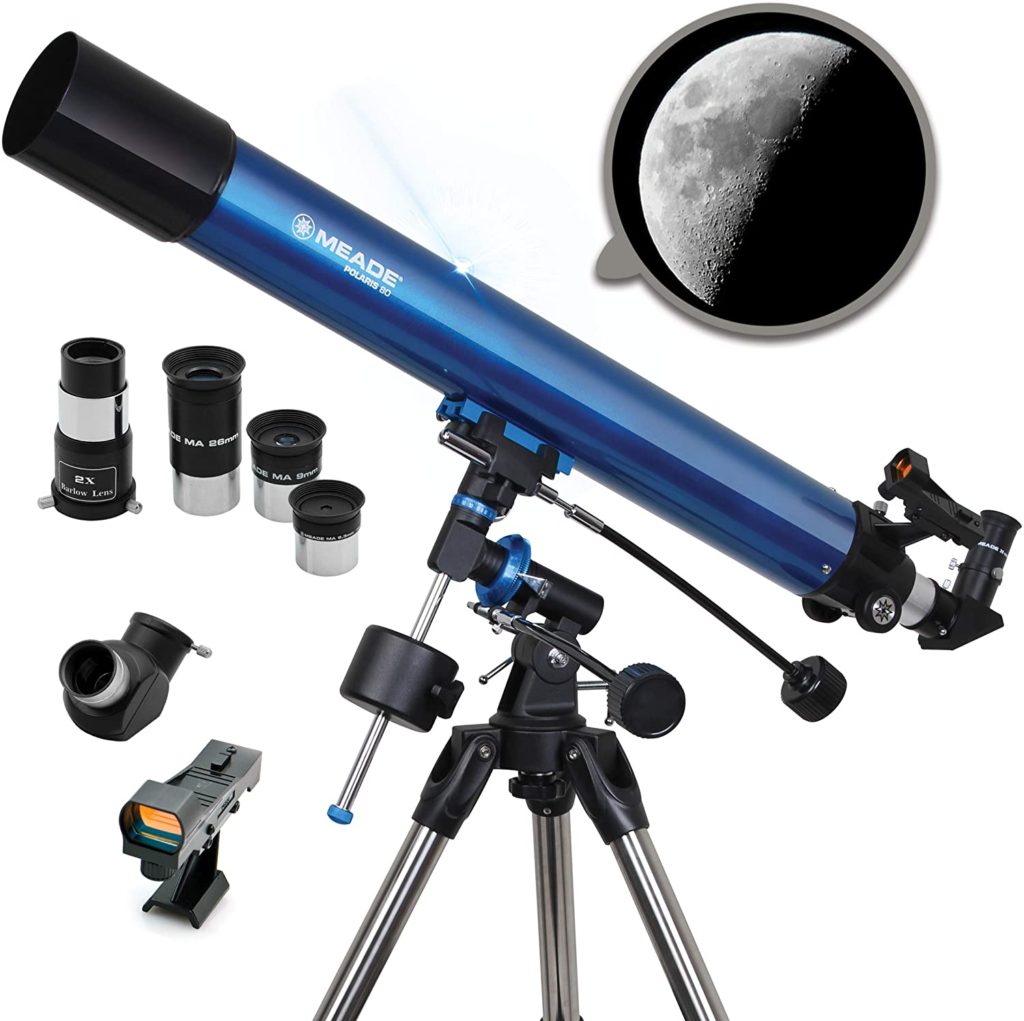
It comes with a basic red dot finder. The red dot finder is quite common among beginner telescopes. It simply reflects a red dot on the sky so you can easily focus on the object. For such a high-magnification telescope you may need a better finder such as a 6×30. But the red dot will prove enough for the beginning.
The focuser is a rack-and-pinion model. It is 1.25 inches in size and mostly plastic. It is surprisingly smooth and solid. It doesn’t bring up any complaints about any magnification range. It is a little stiff in the beginning but it loosens up in time. It will work well with any 1.25-inch eyepiece in the market.
The 2x Barlow lens is mostly plastic but it does its job quite well. But we recommend lower aperture eyepieces instead of a Barlow for high-powers. A 6mm Goldline eyepiece would do the job.
The Meade Infinity is absolutely one of the best telescopes for planets and galaxies under $200.
The 90-degree prism corrects the images’ rotation and saves you from bending over to look at the images. We highly recommend it for terrestrial observations.
Pros:
- Strong
- Durable frame
- Adjustable tripod
- Viewfinder
- Elegant moveable mount
Cons:
- Doesn’t come with a smartphone adaptor
Related
Best Reflector Pick
Orion 10015 StarBlast 4.5
- Type: Newtonian Reflector
- Aperture: 115mm (4.53″)
- Focal length: 450mm
- Focal Ratio: f/4
- Mount: Altazimuth
- Eyepiece: 17mm, 6mm
- Magnification: 26x, 75x
- Weight: 13 lbs(5.9 kg)
- Our Rating: 9/10
Prices pulled from the Amazon Product Advertising API on:
Product prices and availability are accurate as of the date/time indicated and are subject to change. Any price and availability information displayed on [relevant Amazon Site(s), as applicable] at the time of purchase will apply to the purchase of this product.
The Orion StarBlast 4.5 (10015) is an excellent choice of telescope for beginners who are eager to begin their astronomical careers, as well as for intermediate astronomers looking for a budget travel telescope, who can utilize its features for the best extraterrestrial viewing.
You don’t have to spend time assembling the Orion 10015 StarBlast 4.5 Astro Reflector, as the telescope arrives pre-built so that anyone can take it out of the box and begin using it right away. It’s a great compact and highly portable budget telescope for beginners and families.
The scope features a substantial 4.5″ aperture and f/4 focal ratio that provides bright, detailed views of solar system targets like the Moon and planets, as well as wide-field celestial objects like nebulas and star clusters.
The telescope’s lens is made of a low thermal expansion borosilicate glass. This means that it is capable of focusing light with increased precision.
The StarBlast’s included red-dot finder is more than adequate, thanks to its extremely wide field of view.
The model only comes with a tabletop mount, so it really can only be used indoors or outdoors on a picnic table or similar piece of patio furniture.
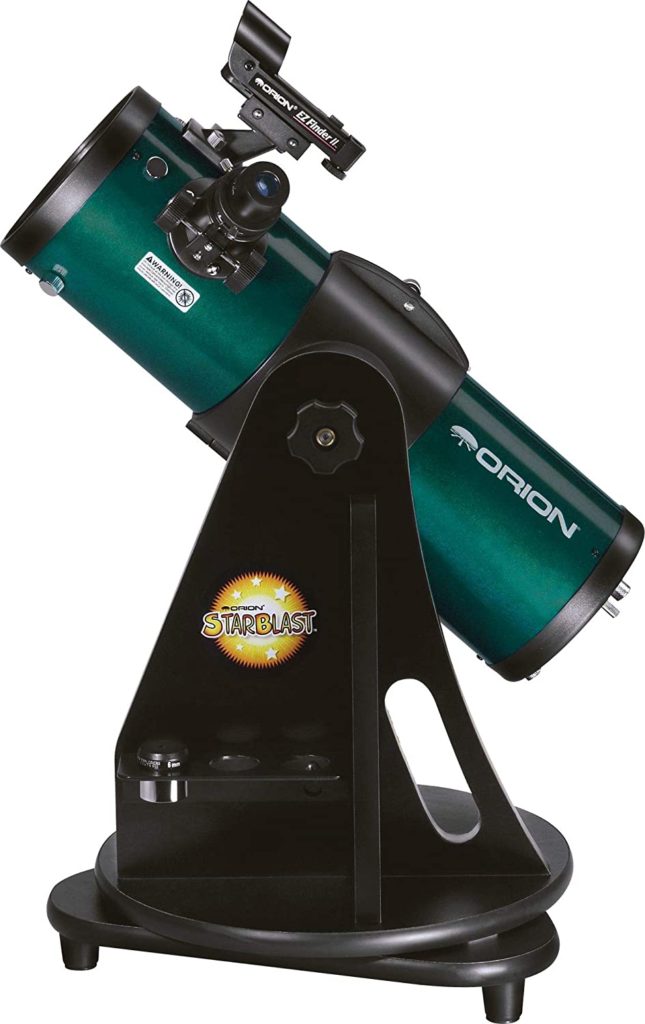
Its table top design makes it one of the best portable telescopes under 200. It has a wider footprint than some competing models, which makes it more steady and less prone to being knocked over.
On clear nights, you will be able to view not only the Moon and its craters, but also Jupiter, Saturn, and its beautiful rings.
The scope’s Dobsonian mount means that beginners and new users can point easily. All in all, the Orion Starblast 4.5 will enchant even advanced users with its bright images of the galaxies, nebulas, and star clusters.
Pros:
- Simple to use
- Equipped with EZ Finder for easy aiming
- Includes Starry Night astronomy software
- Features a fast-focal ratio
- Comes pre-assembled
- Two eyepieces along with a dust cover in this telescope
Cons:
- Cannot attach DSLRs
- Collimation process takes a lot of time
Best Refractor
Celestron – AstroMaster 70AZ
- Type:Refractor
- Aperture: 70mm (2.8″)
- Focal length: 900mm
- Focal Ratio: f/13
- Mount: Alt-Azimuth
- Eyepiece: 20mm,10mm
- Magnification: 45x, 90x
- Weight: 11.0 lbs (5.0 kg)
- Our Rating: 9.2/10
Prices pulled from the Amazon Product Advertising API on:
Product prices and availability are accurate as of the date/time indicated and are subject to change. Any price and availability information displayed on [relevant Amazon Site(s), as applicable] at the time of purchase will apply to the purchase of this product.
With 70mm aperture and mounted on an altazimuth mount. It’s an entry level telescope that has several nice features that make it a great option for the beginner astronomer.
The AstroMaster 70 is a 70mm f/12 achromatic refractor, using a standard Fraunhofer configuration with crown and flint glasses for the objective lens. The long focal ratio means that there is not much chromatic aberration (false color).
Its medium aperture and long focal length allow it to draw in a generous amount of light with a high magnification potential to allow observation of the larger planets and the moon.
The included 90° diagonal has an integrated erecting prism that corrects the view to enable the scope’s use on land. Celestron includes two eyepieces for high and medium magnifications.
The Astromaster 70 AZ comes with two eyepieces (20 mm and 10 mm respectively) and a StarPointer Finderscope.
One of the best features of the Celestron 21061 AstroMaster 70 AZ Telescope is that the StarPointer is permanently fixed right next to the eyepiece. Moreover, it uses the red dot technology for lining up a celestial object, a feature you can find on more advanced and expensive telescopes.
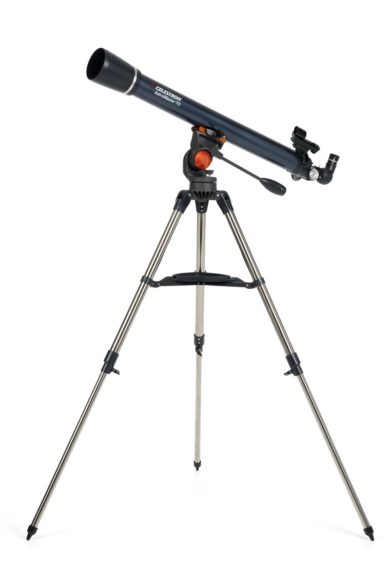
The AstroMaster 70 has a 1.25” rack and pinion focuser which is mostly plastic. It works well.
The red-dot finder is attached to the left side of the focuser and is more than adequate for a small scope such as a 70mm refractor.
The telescope makes it possible to view the moon, stars, planets and nebulae, and on very clear nights, it can even allow a user to catch sight of the moons of Jupiter and the rings of Saturn.
The telescope has multi-coated optics that minimize the breakdown of light as it passes through the telescope, ensuring that images are bright and clear.
The AstroMaster is outfitted with a manual alt-azimuth mount and to make finding and tracking objects easy, there is an altitude control handle and an azimuth lock. Supporting the mount and optical tube is a stainless-steel tripod with sturdy 1.25″ diameter legs.
The scope can magnify objects by up to 165 times their size, and has a convenient accessory tray.
With the telescope, you receive access to a database that includes 10,000 celestial objects.
This allows children to learn more about what they’re seeing in the night sky, and to find out what objects to look for during stargazing sessions on any particular night of the year.
Pros:
- Great value for money
- Comes with fully coated professional lenses
- Can also be used for terrestrial viewing
- Perfect for beginners and kids
- Requires no tool to setup
- Easy to use
Cons:
- Sensitive to heat
- Mount is small, a bit short for an average adult
Best Telescope For Astrophotography
Gskyer Telescope, 80mm
- Type: Refractor
- Aperture: 80mm (3.2″)
- Focal length: 400mm
- Focal Ratio: f/5
- Mount: Equatorial
- Barlow lens: 3x
- Eyepiece: 5mm, 10mm, 25mm
- Magnification: 16x, 40x, 80x
- Weight: 18 lbs.(8.2 kg)
- Our Rating: 8/10
The Gskyer 80mm AZ Space Astronomical Refractor Telescope is great for people who are interested in learning more about the distant objects in space as well as on land. The telescope includes a 3x Barlow lens and comes with a large 80mm aperture, a focal length of 400mm and focal ratio of f/5. It also features 3 glass eyepieces having focal lengths of 5mm, 10mm and 25mm respectively, enabling several degrees of high-powered magnification.
The Gskyer Instruments Infinity 80 mm telescope comes with all the instructions to get you started. Straight out of the box, the telescope is easy to put together, and only takes 20 – 30 minutes before you are up and running with your new telescope.
That is the really exciting part, this telescope is designed to be used for fun and exciting astronomy, not the technical aspects of advanced techniques and so on.
But you still get an incredibly high quality optical instrument, with powerful and clear optical lenses, and high powered eyepieces are all included in the very attractive price. Even though it is positioned at the lower end of the market.
This is one of the best telescope for smartphone astrophotography under $200 as you also get a smartphone adapter with this telescope model.
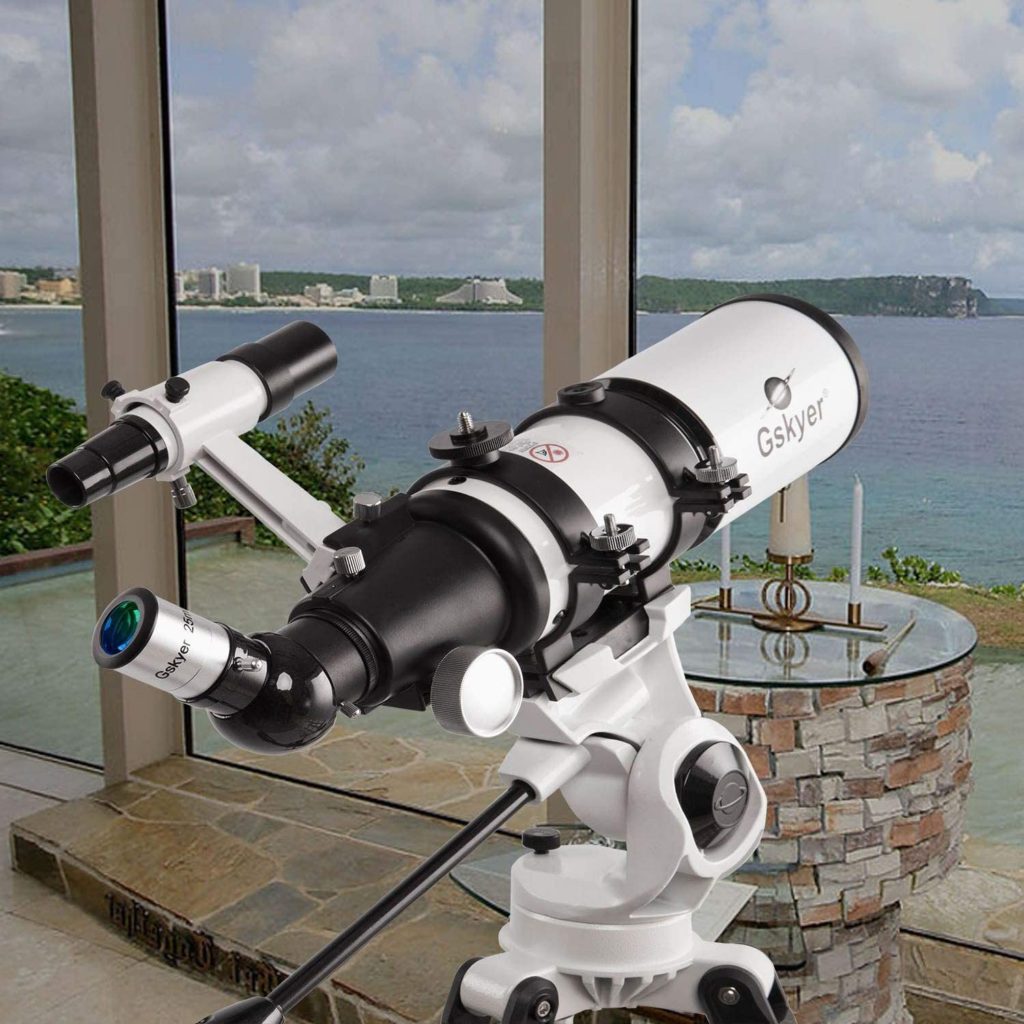
The Gskyer Infinity 80 mm telescope is a modern lightweight device that is extremely versatile and easy to set up and easy to use almost anywhere. You can pack it up and take it with you when you travel on holidays, or you can set it up with ease in your very own backyard.
Despite its light weight and small size, it offers ample power and magnification for viewing of all of the major planets within the solar system, and provides especially bright and clear images of the features of the moon.
Pros:
- Light in weight and compact in design
- Front and back lenses are fully coated
- Available with 1-year warranty
- Inexpensive
- Adjustable and pre assembled stainless-steel tripod
- Durable
- High-powered magnifications
Cons:
- Small tripod
Best Tabletop Reflector Telescope
Zhumell Z114
- Type: Reflector
- Aperture: 114mm (4.49″)
- Focal length: 465mm
- Focal Ratio: f/4
- Mount: Alt-Azimuth
- Eyepiece: 10mm, 17mm
- Magnification: 27x, 46x
- Weight: 11 lbs.(5 kg)
- Our Rating: 8.4/10
Prices pulled from the Amazon Product Advertising API on:
Product prices and availability are accurate as of the date/time indicated and are subject to change. Any price and availability information displayed on [relevant Amazon Site(s), as applicable] at the time of purchase will apply to the purchase of this product.
Z114 has great build quality and optics. It is extremely portable. It is absolutely recommended for beginners who are just starting out and intermediate astronomers who would like a telescope to scan the sky for just a few minutes.
The great thing about the Zhumell Z114 is that at such a low price point you get a build quality that is at the level of 10” to 12” telescopes, which is amazing. It is sturdy, stable, the mount is smooth and the optical tube feels surprisingly solid and well made.
It has a tabletop design that provides even more stability. But be sure you have a stable surface to put your telescope on. There are rubbers on the bottom of the mount so don’t worry about scratching the table or any other surface you put the telescope on.
Z114 is undoubtedly one of the best reflector telescopes under $200 available in the market today.
High-end features such as the 114 mm parabolic primary mirror built into the Zhumell Z114 are typically not found in telescopes of this size. This parabolic mirror eliminates spherical aberration and other visual defects for views that are considerably sharper.
Better than 90% light transmission will provide consistently brighter views of fainter objects like nebulae and other deep space objects.
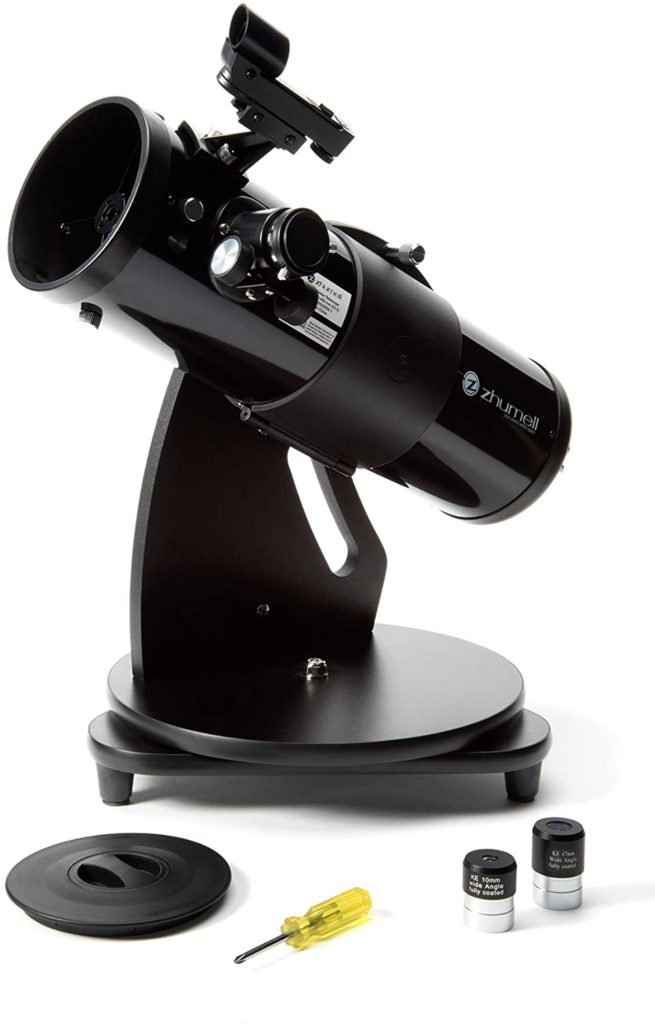
Accessories you’ll receive with this Zhumell Z114 Dobsonian Reflector kit include a red dot finderscope and two fully multi-coated eyepieces, a 17 mm eyepiece with 24x magnification for wide field views, and a 10 mm eyepiece with higher 40x magnification.
Industry-leading optical components allow the Zhumell Z114 to easily surpass the competition from similar-sized tabletop telescopes. The difference will be readily apparent to the user. With the Z114, Zhumell has concentrated your money in the optical system where it belongs.
It is also one of the best travel telescope to just grab and go to your observing site. The Z114’s mechanical design is simple and streamlined. A durable, sturdy construction means your Zhumell will stand up to years of use and travel. Thanks to its compact size and weight, you can confidently pack it along for camping trips, vacations, and more.
When you arrive at your observing site, the telescope comes together in seconds. Once you’re set up, swing the scope on its lazy susan-style mount toward your desired object. Center your target in the Red Dot Finderscope, you’re ready to view it through the eyepiece. Then, make small adjustments to smoothly track objects as they drift across the sky.
Pros:
- Sturdy
- Durable
- Lightweight & portable
- High magnification
- Large aperture
Cons:
- It’s a beginners telescope
Best Portable
Emarth Telescope
- Type: Newtonian Reflector
- Aperture: 70mm (2.75″)
- Focal length: 360mm
- Focal Ratio: f/5.1
- Mount: Altazimuth
- Eyepiece: 25mm, 10mm
- Barlow Lens: 3x
- Magnification: 51x, 128x
- Weight: 2.87 lbs. (1.3 kg)
- Our Rating: 8.4/10
Prices pulled from the Amazon Product Advertising API on:
Product prices and availability are accurate as of the date/time indicated and are subject to change. Any price and availability information displayed on [relevant Amazon Site(s), as applicable] at the time of purchase will apply to the purchase of this product.
The Emarth travel telescope is one of the best starter telescopes under $200.
It’s equipped with a lens that has 360mm focal length and 70mm aperture. It comes with coated glass to make moon watching the best experience for the user.
It’s super easy to use and can be an excellent educational and fun gift for your child. If your child enjoys watching and exploring stars, then he or she will surely enjoy it’s 5×24 finder scope.
This model is very easy to assemble, and shouldn’t take more than a few minutes to set up.
It also comes with two eyepieces, a 10mm and a 25mm, which are slightly better than most eyepieces included at this price point.
It uses a BAK-4 prism for better viewing and it comes along with a solar system map.
The Travel Scope provides clean, crisp views. Developed with the traveler in mind,this travel scope features a compact and portable design perfect for the on-the-go stargazer.
Pros:
- Compact and lightweight, easy to carry
- Comes with its own carry case
- Easy to setup and use
- Perfect for kids
Cons:
- Small tripod
Best For The Moon
Orion StarBlast II 4.5
- Type: Reflector
- Aperture: 114mm (4.5″)
- Focal length: 450mm
- Focal Ratio: f/4
- Mount: Equatorial
- Eyepiece: 25mm, 10mm
- Magnification: 18x, 45x
- Weight: 20.7 lbs.(9.4 kg)
- Our Rating: 9.4/10
Prices pulled from the Amazon Product Advertising API on:
Product prices and availability are accurate as of the date/time indicated and are subject to change. Any price and availability information displayed on [relevant Amazon Site(s), as applicable] at the time of purchase will apply to the purchase of this product.
The StarBlast II 4.5 EQ is one of the best reflector telescope for beginners under 200 which the whole family can also enjoy, thanks to its great optics, convenient portability, and easy-to-use operation.
Views of everything from the Moon and planets to distant objects like star clusters and galaxies appear bright and clear through this amazing telescope.
It works amazingly well with the included Expanse telescope eyepieces which yield a very wide 66° apparent field of view that allows you to see distant deep space objects as well as moon and planets.
The included 25mm Sirius Plossl eyepiece provides 18x power magnification, while the 10mm Sirius Plossl eyepiece bumps up the power to 45x magnification. The 25mm is a great eyepiece to begin observing sessions with, since it provides a large window of night sky for you to view.
The telescope’s combination of short 450mm focal length and sizable 4.5″ aperture means the StarBlast II 4.5 EQ will provide brighter views at any magnification compared to longer focal length telescopes, which makes it easier for everyone, and especially beginners, to locate interesting sights in the night sky.
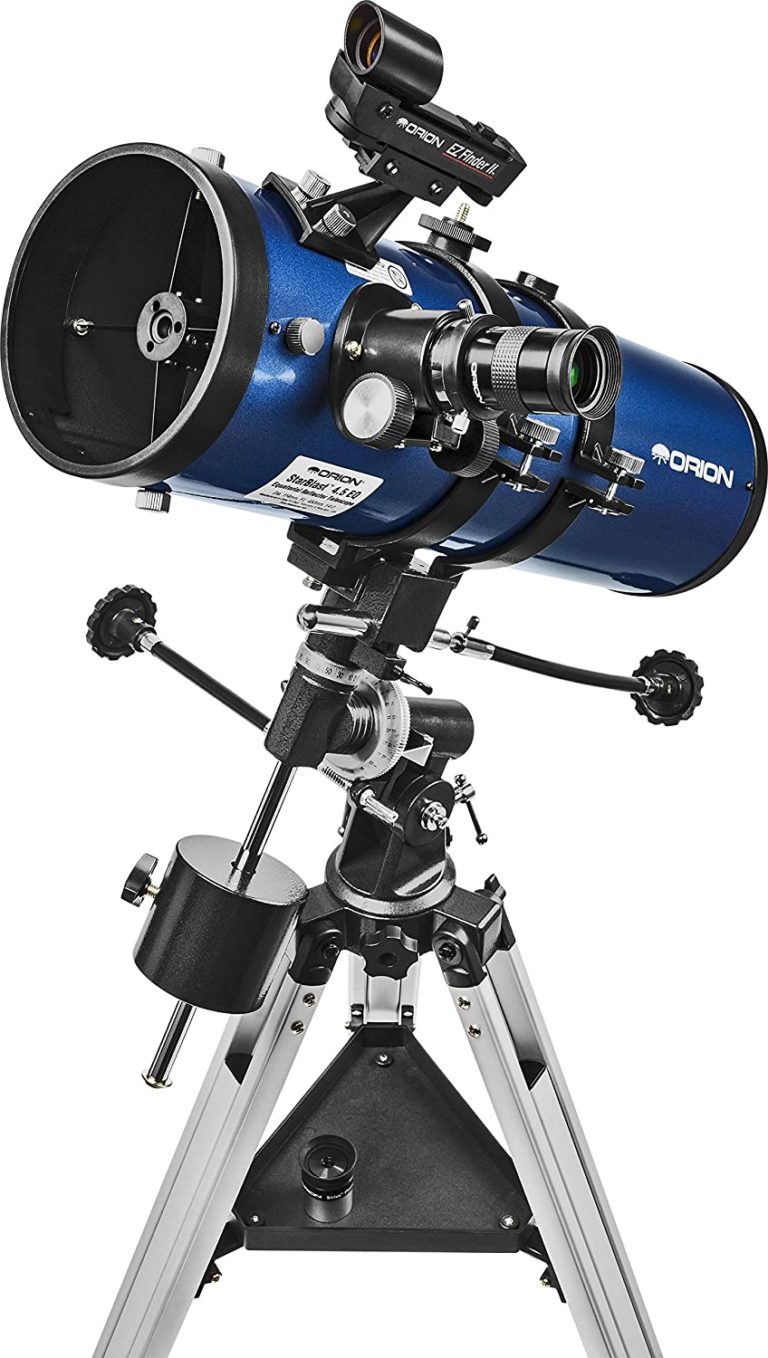
The StarBlast II sits inside two felt-lined tube rings that bolt onto the EQ-1 mount’s top plate – larger/more expensive equatorials use a Vixen dovetail and saddle which is slightly more convenient, but the simple system used with the StarBlast II works just fine.
Setting up and using the EQ-1 is pretty easy – just level the tripod, put the mount/scope together, balance the scope on both axes, and roughly line up the mount’s polar axis with Polaris.
Thanks to this design, it’s easy for anyone in the family to manually track a celestial object using slow-motion control cables. You can even add an optional electronic motor drive (sold separately) to the EQ-1 equatorial mount so it can track objects automatically once you’ve centered the object in the telescope eyepiece.
Pros:
- Wide field of view
- Lightweight and portable
- Easy to use
- Compatible with high-quality accessories
- Suitable for astrophotography
- Great for beginners and families with children
- Sturdy equatorial mount
Cons:
- No finder scope
- Not suitable for use in daylight
Best Telescope For Planets
Celestron – PowerSeeker 80EQ
- Aperture: 80 mm (3.15″)
- Focal length: 900mm
- Focal Ratio: f/11
- Mount: Equatorial
- Eyepiece: 20mm, 4mm
- Magnification: 45x, 225x
- Weight: 16.38 lbs (7.4 kg)
- Our Rating: 9/10
Prices pulled from the Amazon Product Advertising API on:
Product prices and availability are accurate as of the date/time indicated and are subject to change. Any price and availability information displayed on [relevant Amazon Site(s), as applicable] at the time of purchase will apply to the purchase of this product.
The 70EQ Power Seeker is a refractor telescope with a 80mm aperture and a focal length of 900mm. Its low price combined with excellent optics, easy assembly, clear instructions, included eyepieces and other features that make it easy to use even for beginners, make it an excellent choice for anyone wanting to learn more about the nighttime sky.
At f/11, there is some chromatic aberration but nothing significant enough to ruin high-power views with this telescope. The optical quality of the Powerseeker 70 is quite good.
The scope’s focuser is a 1.25” rack-and-pinion made mostly of plastic. The focuser even includes a tension adjustment knob, should you find the focuser to be too loose or too tight.
Since Celestron PowerSeeker 80EQ telescope is a family-friendly scope, it is very easy to set up and use as it needs no extra tools. The instructions manual clearly describes every setup step, giving clear information on each of the telescope’s parts and uses.
With an aperture of 80 mm (3.15″) and a focal length of 900 mm (35″), the Celestron Power Seeker telescope allows stargazers to see the Moon, Jupiter, Saturn and other celestial wonders with ease.
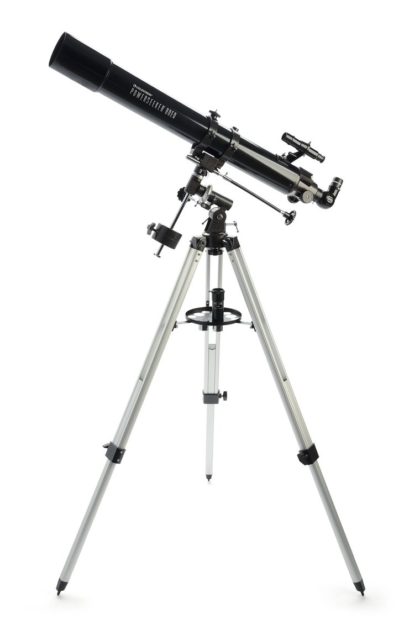
The 3x Barlow lens manages to triple the magnifying power of all eyepieces, while the 1.25″ Erect Image Diagonal makes the telescope ideal for both astronomical and terrestrial use.
The telescope includes fully coated optics, meaning that at least one lens in the telescope has been coated with multiple layers of substances designed to capture and focus the light that goes through the lens.
The equatorial mount supplied with the 80EQ is actually a good match for it. The motions are reasonably smooth, the mount’s extruded aluminum legs are quite steady with such a lightweight tube. Furthermore, the whole setup is pretty light at about 16 pounds.
The 80EQ PowerSeeker is the best telescope for iphone astrophotography under 200 as it comes with a camera attachment that allows the user to take photographs of the objects being viewed.
Pros:
- Family-friendly, easy to setup and use
- Coated glass, decent optical components
- EQ mount with slow motion controls
- Budget option refractor telescope for astrophotography
- High and low power eyepieces
- Ideal for both terrestrial and celestial viewing
Cons:
- Not suitable for professional use
- Most components are built with plastic
Best To See Jupiter’s Moons
Orion SpaceProbe II
- Type: Reflector
- Aperture: 76mm (3″)
- Focal length: 700mm
- Focal Ratio: f/9.2
- Mount: Alt-Azimuth
- Eyepiece: 10mm, 25mm
- Magnification: 70x, 28x
- Weight: 7 lbs.(3 kg)
- Our Rating: 8.6/10
Prices pulled from the Amazon Product Advertising API on:
Product prices and availability are accurate as of the date/time indicated and are subject to change. Any price and availability information displayed on [relevant Amazon Site(s), as applicable] at the time of purchase will apply to the purchase of this product.
The petite SpaceProbe II 76mm AZ Reflector Telescope is a great choice for anyone who is curious about space and the stars. The telescope’s 3″ aperture (or diameter) gathers a good amount of light from the night sky, for impressively bright and detailed views of celestial wonders.
The rest of the family will want to join in the fun for great views of the Moon, bright planets, and star clusters seen through the SpaceProbe II 76mm. This telescope is a complete, full-fledged reflector that will help foster a lifetime of appreciation for science and astronomy.
This inexpensive reflector telescope will amaze you with revealing views of Saturn’s picturesque rings, Jupiter’s moons, and the beautifully cratered terrain of our own Moon’s surface.
Its 3″ (76mm) primary mirror gathers enough light to snare the faint glows of some very exotic star clusters and distant nebulas too. The SpaceProbe II 76mm telescope’s focal length of 700mm (f/9.2) provides sharp views of cosmic curiosities the whole family can enjoy.
The Newtonian reflector optical tube is made of aluminum and it features a 1.25″ rack-and-pinion focuser for use with standard size eyepieces to provide a sharp image and large field-of-view.
A wide-field EZ Finder II reflex sight is also included to aid in locating objects and aiming the SpaceProbe 3 telescope.
The adjustable-height Altazimuth tripod is easier to use than equatorial mounts and includes an accessory tray and aluminum legs.
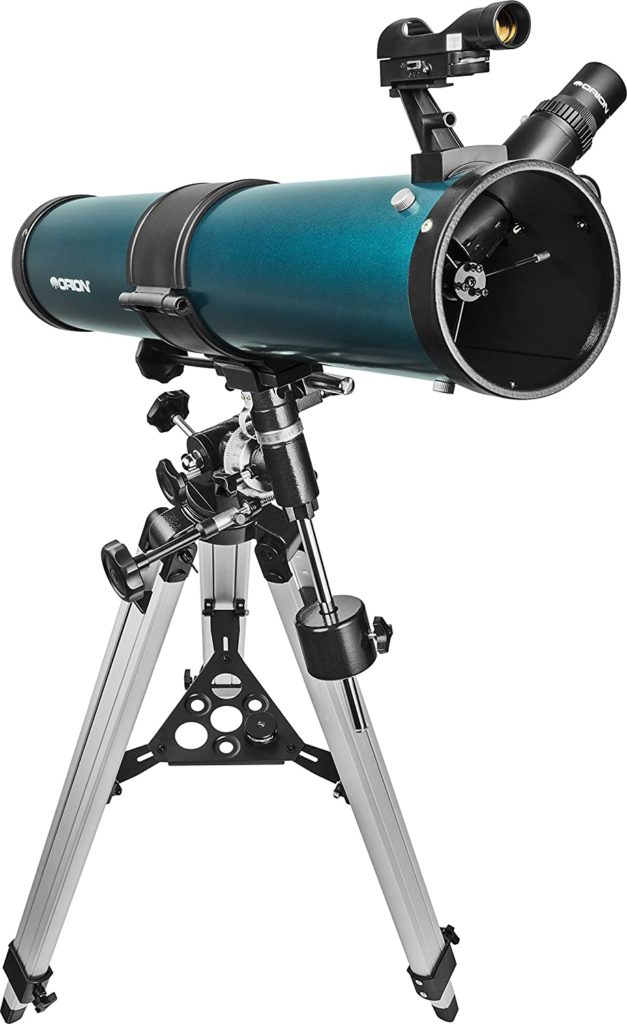
This mount allows for simple up/down and left/right motion. Easy-to-understand instructions are included to get you observing the sky quickly. Ships in one box with some assembly required.
Each Orion SpaceProbe II 76mm Reflector includes two anti-reflection coated 1.25″ Kellner telescope eyepieces, a 25mm and a 10mm, for two different magnification options right out of the box.
The 25mm eyepiece will yield 28x power magnification in the SpaceProbe II 76mm while the 10mm eyepiece boosts the magnification up to 70x power for closer looks. These 1.25″ barrel eyepieces are better and more versatile than smaller .965″ eyepieces you might find with department store telescopes.
An included red-dot sight makes aiming the telescope nice and easy. Following a simple alignment procedure that parents can help with, you can use the red-dot sight to accurately aim the SpaceProbe II 76mm telescope at objects in the sky like the Moon and bright planets.
Once aligned with the telescope, just turn on the red-dot sight and peer through the small circular viewing window so you see the red dot, and move the telescope until the red dot is on the object you want to see.
The Orion SpaceProbe II is also one of the best telescopes to see the moon under $200.
Use the included Orion MoonMap 260 to learn more about the lunar features you see in the telescope. With locations and names of over 260 features on the Moon such as craters, mountains, valleys, “seas” and more.
Pros:
- A fantastic beginner telescope the whole family will enjoy that’s lightweight, easy to set up, and has a very affordable price tag.
- 76mm (3′) aperture reflector telescope is large enough for wonderful views of the Moon, rings of Saturn, moons orbiting Jupiter, and even some brighter nebulas
- Stable altazimuth mount and tripod provides smooth motion in both altitude (up/down) and azimuth (left/right) axes of motion
- Included 25mm and 10mm Kellner eyepieces provide 28x and 70x magnification options right out of the box!
- Includes two 1.25′ telescope eyepieces, red-dot reflex sight, 1.25′ rack and pinion focuser, MoonMap 260 and more.
Cons:
- Starfinder is a little shaky
Best Telescope To See Saturn
Celestron Cometron 114AZ
- Type: Reflector
- Aperture: 114mm (4.49″)
- Focal length: 450mm
- Focal Ratio: f/4
- Mount: Alt-Azimuth
- Eyepiece: 10mm, 20mm
- Magnification: 70x, 28x
- Weight: 8.4 lbs (3.81 kg)
- Our Rating: 8.6/10
Prices pulled from the Amazon Product Advertising API on:
Product prices and availability are accurate as of the date/time indicated and are subject to change. Any price and availability information displayed on [relevant Amazon Site(s), as applicable] at the time of purchase will apply to the purchase of this product.
Even beginning stargazers can catch stunning views of the next comet with Celestron’s Cometron 114AZ. This telescope was designed specifically for viewing comets, but it will serve you well on all of your astronomical endeavors for years to come.
The Celestron 114AZ Newtonian telescope offers a 4.5″ parabolic mirror to capture the sharpest views of comets on their journey toward the Sun, whether they are big and bright or diminutive and faint.
The simple Newtonian reflector optical design, altazimuth mount, and included red-dot finderscope make it easy to navigate the night sky. A steel tripod provides stability, and two high-quality Kellner eyepieces are included to get different magnifications on your chosen objects.
Cometron 114AZ is also a perfect instrument for viewing objects in our solar system and beyond. Its wide field of view renders the Moon, the Milky Way galaxy, and the rings of Saturn in impressive detail.
You’ll even be able to observe the moons of Jupiter as well as distant objects like the Orion Nebula using this 114mm Newtonian reflector.
Pros:
- Sturdy design
- Good tripod
- Value for money
- Good for viewing planets
- Light weight
- Portable
Cons:
- Mount can be a bit shaky
Best Telescope Under $200 - Buying Guide

While a telescope can be one of your most important belongings when you find the right model, it can be a source of unending frustration for you when you end up with the wrong model. We don’t want you to be an unhappy buyer, so consider the factors below before choosing a telescope.
Features To Consider While Choosing A Good Budget Telescope
Types of Telescopes
There are three types of telescopes and each one has their strong and weak points. They are categorized by the abilities to gather light and the way they go about it.
Refractor scopes are better than every other type at viewing through light pollution. Also, they are ideal for planetary and lunar observations.
Reflector scopes, on the other hand, are perfect for deep-sky observation and don’t perform excellently with light pollution. These scopes require regular alignment and adjustment if used regularly.
Compound scopes utilize a mix of reflector and refractor elements. They’re great for general observation of the sky, and they perform well even in areas with light pollution. However, such models are of high-end scopes, and therefore were not included in the list.
Aperture
The aperture is also known as the objective of the telescope. The aperture of the telescope needs to be large and adjustable.
A larger aperture will gather a lot of light and show a much brighter view of the celestial objects. The adjustable feature allows you to change the aperture opening enabling you to shift focus by compromising the brightness of the view.
The larger size of the aperture addresses this issue and allows more light to enter, allowing more exposure and a brighter view.
The different types of telescopes feature apertures that brighten and magnify view in their way. Each with their pros and cons, of course.
Focal Ratio
Focal ratio is the focal length divided by the objective diameter. A long focal ratio implies higher magnification and narrower field of view with a given eyepiece, which is great for observing the moon and planets and double stars.
For such objects, a focal ratio of f/10 or more is ideal. But if you want to see wide views of star clusters, galaxies, and the Milky Way through your best telescope for home use then a lower focal ratio is better. You get less magnification, but you see more of the sky. Wide field telescopes have a focal ratio of f/7 or less.
Focal Length
The focal length of a telescope has a direct influence on the amount of magnification. Basically, what this means is that the longer the scope’s focal length, the higher its magnification. Do not assume that the tube length of the scope is its focal length.
Complex scopes, despite having short tubes, usually deliver a sharp and clear image. This means that longer focal length is achievable through the proper combination of lenses and mirrors.
Magnification
Some modern telescopes feature improved magnification. This range of magnification can be achieved by merely changing the eyepiece. All this is achievable only if the telescope features a large aperture. When more light enters the lens, there are more chances of achieving a more blatant and magnified view.
A smaller aperture will also allow you to magnify the image, but it will not be a sharp and clear image but somewhat blurry and unfocused. The magnification range of telescopes varies. Telescopes that feature around the 50x magnification feature are great at looking at the celestial bodies itself.
You will be able to visualize the moons of Jupiter and the rings of Saturn. Higher magnification is a must if you’re looking to the intricacies of Mars or crusts and marks of Venus. Around 150x should be best to view all the details.
Eyepieces
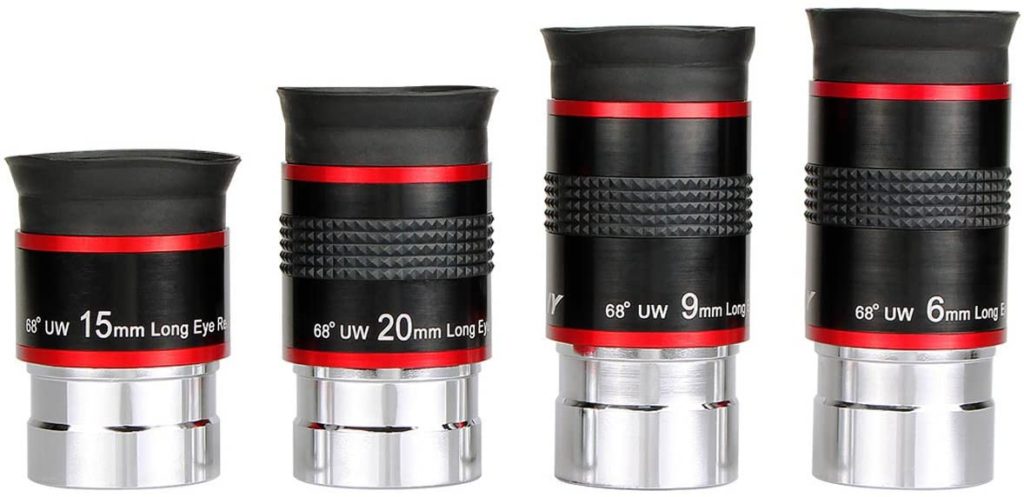
Eyepieces determine the magnification and field of view of a telescope. Different eyepieces are used to view different objects.
Some objects, such as nebulae and star clusters, appear quite large and are best viewed at low magnifications (which give a wider field of view), whereas planets appear very small and are normally viewed with high-magnification eyepieces.
Most telescopes come supplied with one or two eyepieces. Ideally, you’d like to have a set that spans a range of magnifications.
You can expect to spend anywhere from $40 to $200 on a good eyepiece.
A Barlow lens is also worth considering: it multiplies each eyepiece’s power by two or three times, effectively doubling your eyepiece collection.
Mounts
Many telescopes include a mount when purchased. Mounts are important because they can determine how steady you keep the telescope as well as keeping it secured while viewing. There are numerous different types of mounts.
Watch for mounts that are specifically intended for telescopes. These types of mounts are built to accommodate the weight and unique balance required for a telescope.There are some mounts that can be programmed using your geographical location and time of year to find constellations and celestial bodies for you.
These mounts are more expensive but can greatly help you find the objects for which you are looking. Beware of telescopes that can attach to a camera mount. While the telescope may be able to attach to it, the camera mount is more likely to tip over, consequently damaging the telescope. If you decide to use a camera mount, be sure the attachment feature is securely fastened.
Extra Features
The length of a telescope determines the field of view. The shorter the focal length, the wider this field will be, which is essential for deep-sky viewing. Longer tubes create longer focal lengths, showing you a narrower patch of sky for those seeking smaller objects, such as planets or the surface of the Moon.
The warranty is also an extra to check out. Though a decent telescope should last for years, there could be issues you are not prepared for. The better and more extended the warranty, the more piece of mind you’ll have when using it.
An accessory tray is handy to hold your extras within reach. Instructional DVDs, star maps, and other astrological guides make it easy to find what you’re looking for or show you things you may not even know you want to see.
Conclusion
Our first pick for the best beginner telescope under 200 is Celestron – PowerSeeker 127EQ. With this telescope you’ll be ready to observe in minutes thanks to the quick and easy no-tool setup. The 127EQ provides bright, clear images of the Moon, planets, star clusters, and more for great nighttime viewing.
Our next pick is the Orion 10015 StarBlast 4.5 for the best reflector telescope. It’s a great compact grab-and-go telescope designed for entry-level and intermediate astronomy enthusiasts. Its substantial 4.5″ aperture and fast f/4 focal ratio provides bright, detailed views of solar system targets like the Moon and planets, as well as wide-field celestial objects like nebulas and star clusters.
The Gskyer Telescope, 80mm is our next pick for the best telescope for astrophotography under 200. It has 400 mm focal length and 80 mm aperture to capture more light picture and optical glass coated for enhanced image brightness to protect your eyes.
It also comes with three replaceable eyepieces (16X, 40X, 80X) with a 3X Barlow lens. 6*30 finder scope with mounting bracket, erect-image diagonal make locating objects more easily.
If you are still in search of a different telescope model with an extended budget, you should consider telescopes under $500. Yet, if the budget is of more concern, let’s see which affordable telescope you can buy which is best suited to your budget.
ABOUT US
We are a team of active amateur astronomers, here to help you with all your astronomy and science related needs – this is anything, from reviewing the latest telescopes to be released to talking about gravity and neurons. The Big Bang Optics was started because of our love for astronomy and to help others like us find the best telescope and accessories.
LEGAL DISCLAIMER
The Big Bang Optics is a participant in the Amazon Services LLC Associates Program, an affiliate advertising program designed to provide a means for sites to earn advertising fees by advertising and linking to Amazon.com. The Big Bang Optics also participates in affiliate programs with Clickbank and other sites. The Big Bang Optics is compensated for referring traffic and business to these companies.

